spring4+redis3+nginx1实现tomcat7集群实现session共享,我的操作系统为winodw7 64位系统
1.下载redis,我下载的是Redis-x64-3.2.100版本,下载后解压如下
通过cmd窗口启动redis 如下图所示,启动后默认端口号为6379,cmd窗口不能关闭
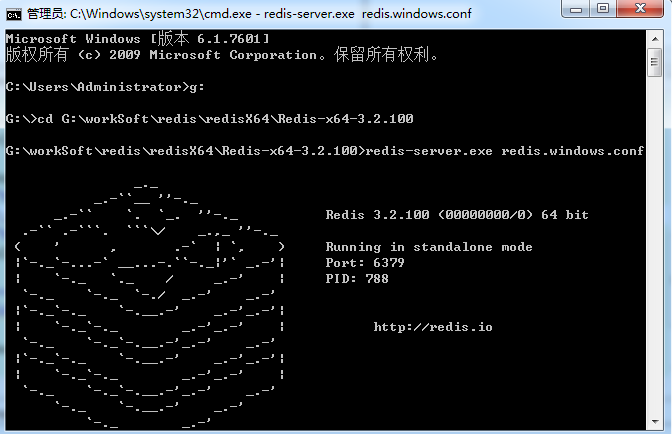
2.使用spring集成redis 我之前的项目是spring3开发的不支持spring-session,所以我把spring的相关jar包升级到了spring4版本,
首先保证用spring4以上版本搭建的web程序可以正常启动,然后添加spring-redis,spring-session等相关的jar。
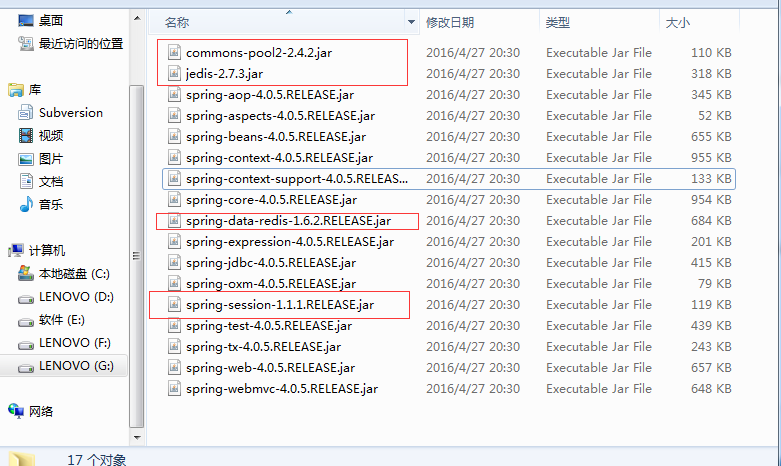
配置web项目 web.xml文件,配置请求拦截器让spring来代理管理httpsession
<filter>
<filter-name>springSessionRepositoryFilter</filter-name>
<filter-class>org.springframework.web.filter.DelegatingFilterProxy</filter-class>
</filter>
<filter-mapping>
<filter-name>springSessionRepositoryFilter</filter-name>
<url-pattern>/*</url-pattern>
</filter-mapping>
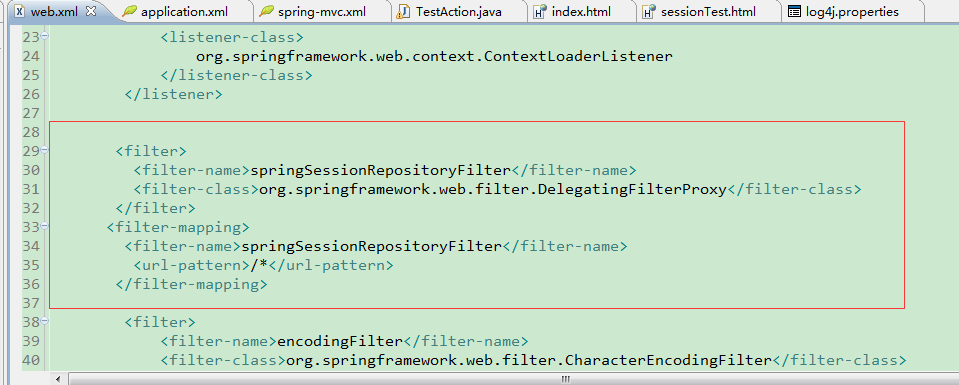
spring配置文件 增加如下代码
<bean class="org.springframework.session.data.redis.config.annotation.web.http.RedisHttpSessionConfiguration">
<property name="maxInactiveIntervalInSeconds" value="3600"></property>
</bean>
<!-- redis连接池 -->
<bean id="poolConfig" class="redis.clients.jedis.JedisPoolConfig"/>
<!-- redis连接工厂 -->
<bean id="connectionFactory" class="org.springframework.data.redis.connection.jedis.JedisConnectionFactory">
<property name="hostName" value="127.0.0.1"/>
<property name="port" value="6379"/>
<property name="password" value=""/>
<property name="timeout" value="20000"/>
<property name="poolConfig" ref="poolConfig"></property>
</bean>
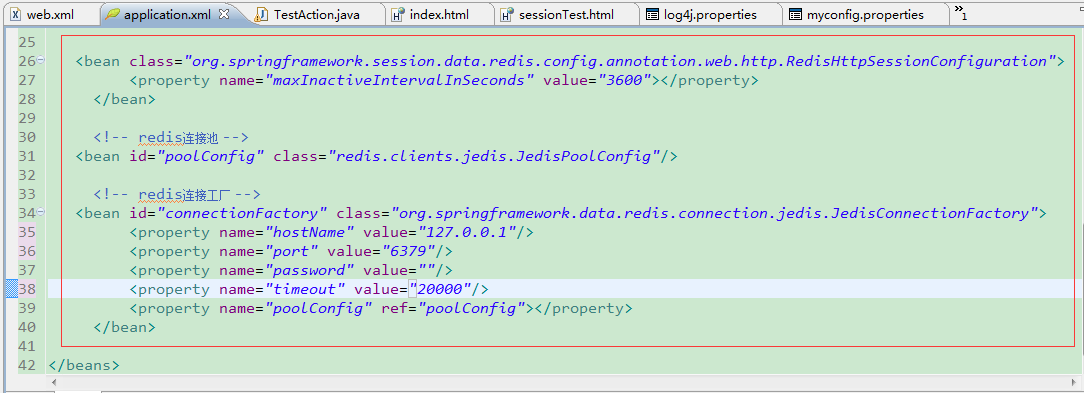
3.下载nginx,我下载版本为nginx-1.13.1
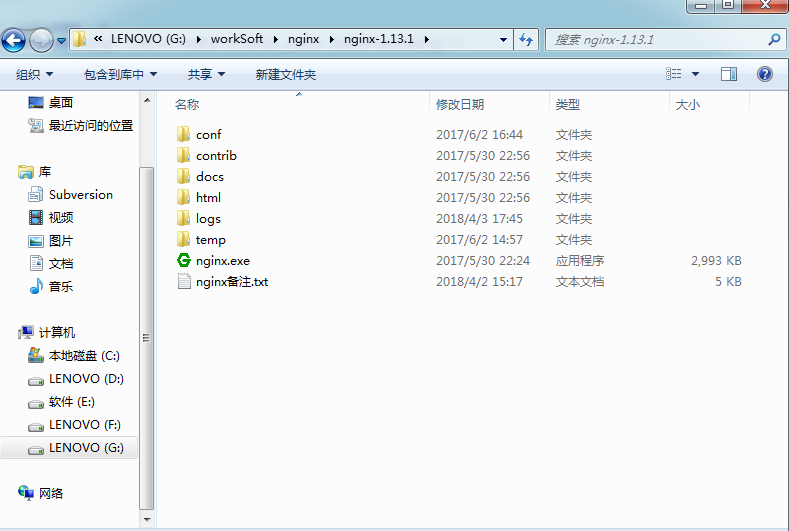
配置nginx,配置文件路径 XXX\nginx\nginx-1.13.1\conf\nginx.conf
#user nobody;
worker_processes 1;
#error_log logs/error.log;
#error_log logs/error.log notice;
#error_log logs/error.log info;
#pid logs/nginx.pid;
events {
worker_connections 1024;
}
http {
include mime.types;
default_type application/octet-stream;
sendfile on;
#tcp_nopush on;
#keepalive_timeout 0;
keepalive_timeout 10;
proxy_connect_timeout 10;
# proxy_read_timeout 1;
# proxy_send_timeout 1;
#gzip on;
#服务器的集群
upstream WYing.com { #服务器集群名字
server 127.0.0.1:8180 ;
server 127.0.0.1:8181 ;
}
server {
listen 80;
server_name localhost;
#charset koi8-r;
#access_log logs/host.access.log main;
#old
#location / {
# root html;
# index index.html index.htm;
# }
#new
location /test {
proxy_pass http://WYing.com;
proxy_redirect default;
}
#error_page 404 /404.html;
# redirect server error pages to the static page /50x.html
#
error_page 500 502 503 504 /50x.html;
location = /50x.html {
root html;
}
}
}
我这里直接把我配置好的贴上,负载均衡我采用的默认的轮询方式,你们根据你们的实际部署的tomcat在我的基础上修改下就行,需要修改的地方如下
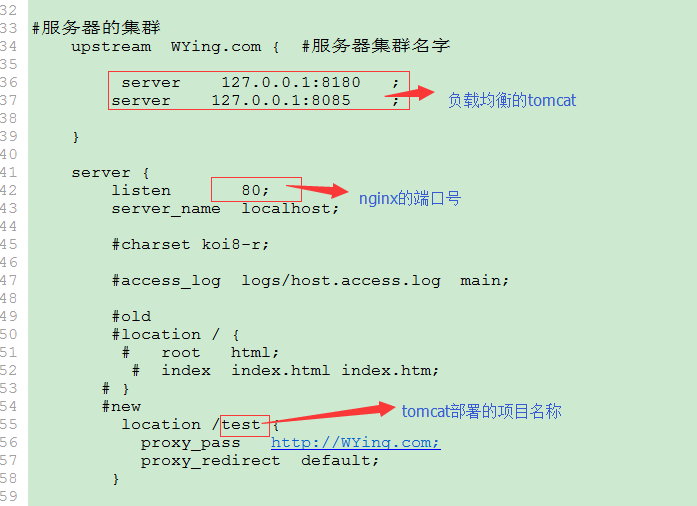
4.使用nginx配置文件里配置的负载均衡的tomcat部署你的web应用, 然后分别启动tomcat,我用的tomcat7+jdk1.7
tomcat启动完毕后使用cmd启动nginx
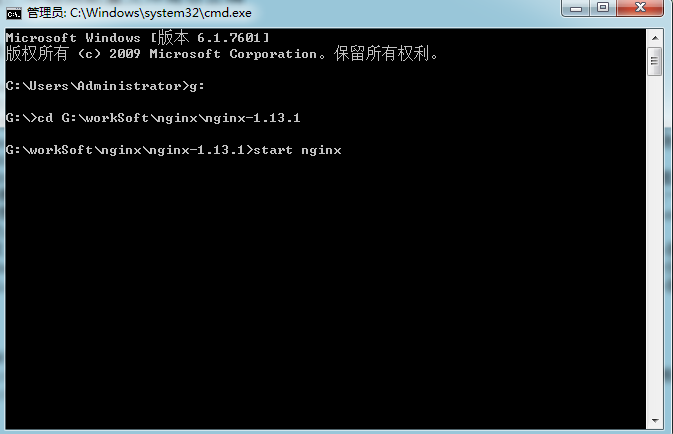
如果前面步骤的顺利的话,那么打开浏览器,试试效果吧
这里我通过nginx访问我的web项目,并且重复刷新了几次页面,可以看到我的2个tomcat都有输出信息,说明nginx会根据轮询机制指定本次请求哪个tomcat处理,然后浏览器测试页面每次输出的sessionID都是一样的,说明spring已经通过redis实现了session共享
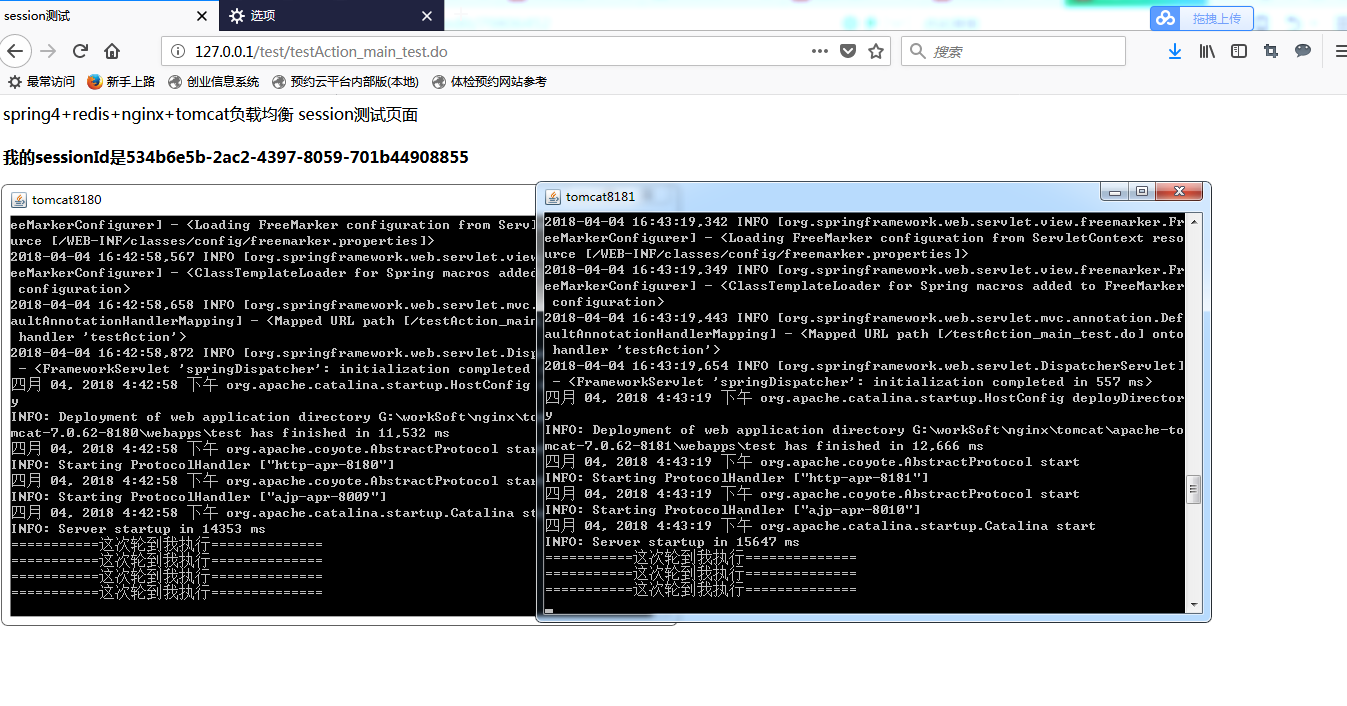
通过spring代理的session共享我们不需要修改任何业务代码,程序里依然通过request.getSession()使用session,最大化的减少了程序的耦合
既然spring把session存到了redis里,那么我们不妨去redis看一下spring存储的session把
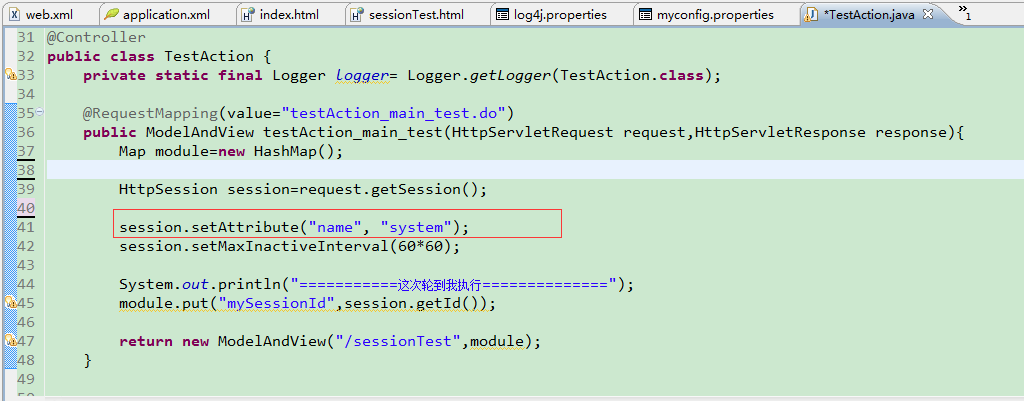
这里我在session存了一个属性name,我们通过redis自带的客户端查看
打开cmd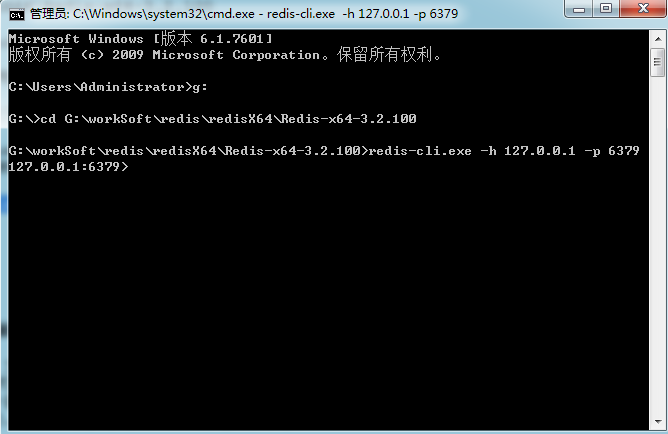
连接到redis后获取所有key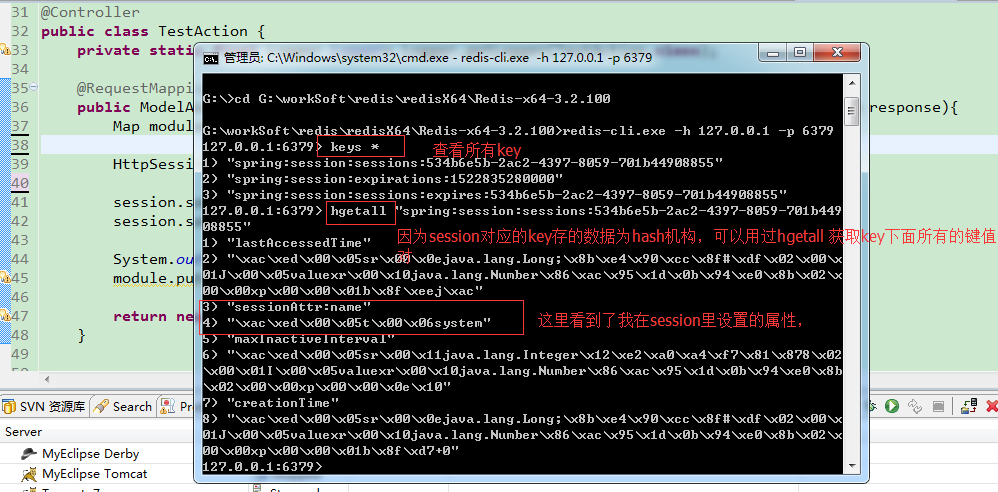
结束了,希望能对大家有所帮助,有不对的地方请指教。
附上我搭建环境用到的redis,nginx和我的web项目源码☺,下载地址https://download.youkuaiyun.com/download/qq445829096/10327902
补充:如果项目session没有实现session共享 又想使用负载均衡增加并发等,nginx提供了ip_hash的方式
(固定一部分IP请求一台服务器,另一部分访问另一台服务器 使用ip_hash不用考虑session共享问题)
upstream WYing.com { #服务器集群名字
ip_hash;
server 127.0.0.1:8085 max_fails=1 fail_timeout=40s ;
server 10.8.0.63:8082 max_fails=1 fail_timeout=40s ;
}
当某个服务宕机时遇到的问题及解决方法(服务都正常运行时负载均衡是没太大问题)
upstream WYing.com { #服务器集群名字
ip_hash;
server 127.0.0.1:8085 ;
server 10.8.0.63:8082 ;
}
使用ip_hash不设置健康检测机制 当8082宕机后 分配的8082请求的IP还是会去请求8082
请求超时默认好像1分钟,nginx才去请求8085,这样导致分配到8082的IP访问网页响应好慢,根本不现实
通过设置proxy_connect_timeout 1;
proxy_read_timeout 1;
proxy_send_timeout 1;
请求超时为1秒 这样当8082宕机后 分配的8082请求的IP去请求8082 1秒没响应
nginx就吧请求分配到8085。这样1秒用户暂时还能接受 ,
但是问题来了,我一个url逻辑比价复杂,需要处理几秒钟,这样1秒钟没响应nginx也当成8082宕机了,
所以我认为proxy_connect_timeout 1; 也不可取
proxy_connect_timeout
后端服务器连接的超时时间_发起握手等候响应超时时间
proxy_read_timeout
连接成功后_等候后端服务器响应时间_其实已经进入后端的排队之中等候处理(也可以说是后端服务器处理请求的时间)
proxy_send_timeout
后端服务器数据回传时间_就是在规定时间之内后端服务器必须传完所有的数据
upstream WYing.com { #服务器集群名字
ip_hash;
server 127.0.0.1:8085 max_fails=1 fail_timeout=40s ;
server 10.8.0.63:8082 max_fails=1 fail_timeout=40s ;
}
通过这样配置 表示开启健康检测机制
max_fails=1 请求无响应最多失败1次
fail_timeout=40s表示请求无响应失败1次后40S不再去访问这个服务器,
40秒后继续访问 ,这样我们只要把fail_timeout调整足够大,
用户请求失败一次后要好久才会重现上述延迟,好像也是可以的
========之前对proxy_connect_timeout 等理解有误
通过设置
proxy_connect_timeout 1;
不设置 proxy_read_timeout ,proxy_send_timeout
proxy_connect_timeout表示nginx发起握手等待响应的时间 ,因为http握手只要服务器没宕机基本很快响应的,
只有响应后才发送request过去,我之前理解为proxy_connect_timeout为发送请求到返回response响应的时间,
现在即使不配置健康检查机制 只要proxy_connect_timeout ;设为1就行,
我认为理论上只要服务器没宕机握手的话医院内网一秒会响应的,当然如果不是内网,外网访问的话网络延迟1秒不能完成也是可能的。。
我们也可以把proxy_connect_timeout稍微调大点,比如3秒,外网的话3秒应该要握手成功吧,如果3秒没成功,默认服务器宕机了,
请求别的服务器,这样用户一个操作要3秒+,虽然慢点,但是可以操作,及时通知管理员重启下宕机服务器就行了
最后附上我正式环境的一个配置 使用的ip_hash 因为程序之前没实现session共享,改造工作量大
该配置文件代理了healthManager,platform项目,同时cytj系统因为并发大,要求稳定性高,做了ip_hash负载均衡
proxy_connect_timeout 3;表示握手3S无响应及判定请求的服务宕机
如果请求healthManager,platform项目,3S无响应返回错误 进去 error_page 500 502 503 504 /50x.html; 错误处理页面
如果请求cytj,3S无响应则去请求另外一个负载服务
#user nobody;
worker_processes 1;
#error_log logs/error.log;
#error_log logs/error.log notice;
#error_log logs/error.log info;
#pid logs/nginx.pid;
events {
worker_connections 1024;
}
http {
include mime.types;
default_type application/octet-stream;
#log_format main '$remote_addr - $remote_user [$time_local] "$request" '
# '$status $body_bytes_sent "$http_referer" '
# '"$http_user_agent" "$http_x_forwarded_for"';
#access_log logs/access.log main;
sendfile on;
#tcp_nopush on;
#keepalive_timeout 0;
keepalive_timeout 65;
proxy_connect_timeout 3;
#gzip on;
proxy_set_header Host $http_host;
client_max_body_size 30m; #最大接受30m文件以内的
upstream bsoft.com { #服务器集群名字
ip_hash;
server 127.0.0.1:8089 max_fails=1 fail_timeout=100s ;
server 127.0.0.1:8083 max_fails=1 fail_timeout=100s ;
}
server {
listen 8086;
server_name localhost;
#charset koi8-r;
#access_log logs/host.access.log main;
location / {
root html;
index index.html index.htm;
}
location /healthManager/ {
proxy_pass http://127.0.0.1:8089/healthManager/;
}
location /platform/ {
proxy_pass http://127.0.0.1:8089/platform/;
}
location /cytj/ {
proxy_pass http://bsoft.com;
proxy_redirect default;
}
error_page 404 /404.html;
# redirect server error pages to the static page /50x.html
#
error_page 500 502 503 504 /50x.html;
location = /50x.html {
root html;
}
# proxy the PHP scripts to Apache listening on 127.0.0.1:80
#
#location ~ \.php$ {
# proxy_pass http://127.0.0.1;
#}
# pass the PHP scripts to FastCGI server listening on 127.0.0.1:9000
#
#location ~ \.php$ {
# root html;
# fastcgi_pass 127.0.0.1:9000;
# fastcgi_index index.php;
# fastcgi_param SCRIPT_FILENAME /scripts$fastcgi_script_name;
# include fastcgi_params;
#}
# deny access to .htaccess files, if Apache's document root
# concurs with nginx's one
#
#location ~ /\.ht {
# deny all;
#}
}
# another virtual host using mix of IP-, name-, and port-based configuration
#
#server {
# listen 8000;
# listen somename:8080;
# server_name somename alias another.alias;
# location / {
# root html;
# index index.html index.htm;
# }
#}
# HTTPS server
#
#server {
# listen 443 ssl;
# server_name localhost;
# ssl_certificate cert.pem;
# ssl_certificate_key cert.key;
# ssl_session_cache shared:SSL:1m;
# ssl_session_timeout 5m;
# ssl_ciphers HIGH:!aNULL:!MD5;
# ssl_prefer_server_ciphers on;
# location / {
# root html;
# index index.html index.htm;
# }
#}
}





 本文介绍如何使用Spring、Redis和Nginx实现Tomcat集群的Session共享,包括安装配置Redis、集成Spring Session、配置Nginx负载均衡等内容。
本文介绍如何使用Spring、Redis和Nginx实现Tomcat集群的Session共享,包括安装配置Redis、集成Spring Session、配置Nginx负载均衡等内容。
















 38
38

 被折叠的 条评论
为什么被折叠?
被折叠的 条评论
为什么被折叠?








